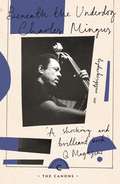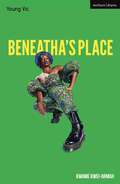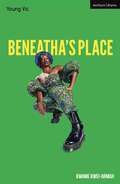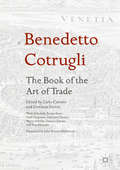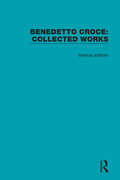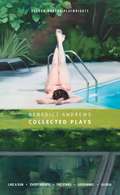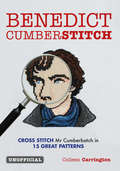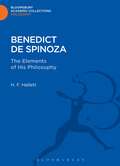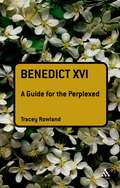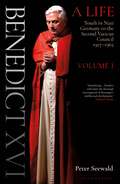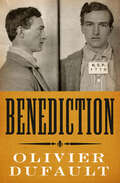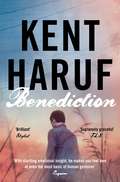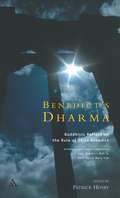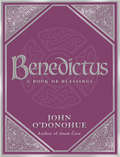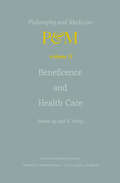- Table View
- List View
Beneath These Red Cliffs: An Ethnohistory of the Utah Paiutes
by Ronald L HoltRonald Holt recounts the survival of a people against all odds. A compound of rapid white settlement of the most productive Southern Paiute homelands, especially their farmlands near tributaries of the Colorado River; conversion by and labor for the Mormon settlers; and government neglect placed the Utah Paiutes in a state of dependency that ironically culminated in the 1957 termination of their status as federally recognized Indians. That recognition and attendant services were not restored until 1980, in an act that revived the Paiutes’ identity, self-government, land ownership, and sense of possibility. With a foreword by Lora Tom, chair of the Paiute Indian Tribe of Utah.
Beneath these Stones: A murderous English village crime novel (Meredith And Markby Mysteries Ser. #12)
by Ann GrangerSuperintendent Markby faces one of his most complex cases yet...With her step-mother murdered just two years after the death of her mother, twelve-year-old Tammy Franklin is also at risk of becoming fatherless, because he is suspect number one. Beneath These Stones is the twelfth cosy Cotswolds crime novel in Ann Granger's Mitchell & Markby series. The perfect read for fans of Ruth Rendell, Agatha Christie and ITV's Midsomer Murders.'A murder mystery that will give you the excuse you need to stay indoors during these dark nights and enjoy a good read' - Hartlepool Mail Twelve-year-old Tammy Franklin has learned too much about death, too quickly. Two years ago she lost her mother to a long, lingering illness and now the body of the woman her father married in an attempt to replace his wife has been found on a railway embankment close to the Franklin farm. This time the death is murder. As Superintendent Markby, one of the first on the scene, well knows, Tammy now stands to have her father taken from her, for Hugh Franklin is suspect number one in the mind of the inspector to whom Markby has delegated the case. But, despite his need to distance himself from the murder, Markby begins to realise that the truth is destined to be far more complex than he ever envisaged...What readers are saying about Beneath These Stones:'I enjoyed this well written crime novel and thought the characters were well drawn and interesting''An excellent enjoyable read''The mystery plot is sound and raised above the norm by the existence of plausible characters - including Meredith Mitchell and Alan Markby'
Beneath The Underdog: His World As Composed By Mingus (Canons #7)
by Charles MingusBass player extraordinaire Charles Mingus, who died in 1979, is one of the essential composers in the history of jazz, and Beneath the Underdog, his celebrated, wild, funny, demonic, anguished, shocking and profoundly moving memoir, is the greatest autobiography ever written by a jazz musician. It tells of his God-haunted childhood in Watts during the 1920s and 1930s; his outcast adolescent years; his apprenticeship, not only with jazzmen but also with pimps, hookers, junkies, and hoodlums; and his golden years in New York City with such legendary figures as Duke Ellington, Lionel Hampton, Miles Davis, Charlie Parker, and Dizzy Gillespie. Here is Mingus in his own words, from shabby roadhouses to fabulous estates, from the psychiatric wards of Bellevue to worlds of mysticism and solitude, but for all his travels never straying too far, always returning to music.
Beneatha's Place (Modern Plays)
by Kwame Kwei-ArmahSome things we do for those we are responsible for, some things for ourselves, and some things we do for the ancestors.Today, it's all three!1959. The first wave of independence is sweeping across Africa and Beneatha has left the prejudice of 1950s America for a brighter future with her Nigerian husband in Lagos. But on the day they move into their new house in the white suburbs, it doesn't take long for cracks to appear, changing the course of the rest of their lives.Present day. Now a renowned Dean whose colleagues are questioning the role of African American studies for future generations, Beneatha returns to the same house in search of answers. Inspired by Lorraine Hansberry's ground-breaking modern classic, A Raisin in the Sun, Beneatha's Place challenges today's culture wars about colonial history and reckoning with the past. A razor-sharp satire from Young Vic Artistic Director Kwame Kwei-Armah, about the power of knowing your history and the cost of letting it go, this edition was published to coincide with the London premiere at the Young Vic Theatre, in June 2023.
Beneatha's Place (Modern Plays)
by Kwame Kwei-ArmahSome things we do for those we are responsible for, some things for ourselves, and some things we do for the ancestors.Today, it's all three!1959. The first wave of independence is sweeping across Africa and Beneatha has left the prejudice of 1950s America for a brighter future with her Nigerian husband in Lagos. But on the day they move into their new house in the white suburbs, it doesn't take long for cracks to appear, changing the course of the rest of their lives.Present day. Now a renowned Dean whose colleagues are questioning the role of African American studies for future generations, Beneatha returns to the same house in search of answers. Inspired by Lorraine Hansberry's ground-breaking modern classic, A Raisin in the Sun, Beneatha's Place challenges today's culture wars about colonial history and reckoning with the past. A razor-sharp satire from Young Vic Artistic Director Kwame Kwei-Armah, about the power of knowing your history and the cost of letting it go, this edition was published to coincide with the London premiere at the Young Vic Theatre, in June 2023.
Benedetto Cotrugli – The Book of the Art of Trade: With Scholarly Essays from Niall Ferguson, Giovanni Favero, Mario Infelise, Tiziano Zanato and Vera Ribaudo
by Carlo Carraro Giovanni Favero John Francis PhillimoreThis is the first English translation of Benedetto Cotrugli's The Book of the Art of Trade, a lively account of the life of a Mediterranean merchant in the Early Renaissance, written in 1458. The book is an impassioned defense of the legitimacy of mercantile practices, and includes the first scholarly mention of double-entry bookkeeping. Its four parts focus respectively on trading techniques, from accounting to insurance, the religion of the merchant, his public life, and family matters. Originally handwritten, the book was printed in 1573 in Venice in an abridged and revised version. This new translation makes reference to the new critical edition, based on an earlier manuscript that has only recently been discovered.With scholarly essays placing Cotrugli's work into historical context and highlighting key themes, this volume is an important contribution to our understanding of the origins of management and trade practices.
Benedetto Cotrugli – The Book of the Art of Trade: With Scholarly Essays from Niall Ferguson, Giovanni Favero, Mario Infelise, Tiziano Zanato and Vera Ribaudo (PDF)
by Carlo Carraro Giovanni Favero John Francis PhillimoreThis is the first English translation of Benedetto Cotrugli's The Book of the Art of Trade, a lively account of the life of a Mediterranean merchant in the Early Renaissance, written in 1458. The book is an impassioned defense of the legitimacy of mercantile practices, and includes the first scholarly mention of double-entry bookkeeping. Its four parts focus respectively on trading techniques, from accounting to insurance, the religion of the merchant, his public life, and family matters. Originally handwritten, the book was printed in 1573 in Venice in an abridged and revised version. This new translation makes reference to the new critical edition, based on an earlier manuscript that has only recently been discovered.With scholarly essays placing Cotrugli's work into historical context and highlighting key themes, this volume is an important contribution to our understanding of the origins of management and trade practices.
Benedetto Croce: Collected Works (Collected Works)
by Various AuthorsOriginally published between 1921 and 1950 the volumes in this collection showcase many of the most important philosophical, political and literary works of Benedetto Croce. The volumes Discuss key political, philosophical and aesthetic issues such as freedom and historical judgment Reveal notes made by Croce from private meetings with Allied forces during 1943 and 1944 Examine and explain the literature of Dante, Goethe, Shakespeare, Ariosto and Corneille Discuss the conception of liberty, liberalism and the relation of individual morality to the State.
Benedict Andrews: Collected Plays (Oberon Modern Playwrights)
by Benedict AndrewsBenedict Andrews is an internationally renowned theatre and opera director, a film-maker and a poet. This volume presents the first collection of original plays by a theatre-maker at the top of his game. Includes the plays Like A Sun, Every Breath, The Stars, Geronimo and Gloria. Introduction by Marius von Mayenburg.
Benedict Cumberstitch: Crossstitch Mr Cumberbatch in 15 great patterns
by Angela WrightYou've watched all his films, you've coloured him in, and, let's face it, you've tried out how your signature would look with 'Cumberbatch' at the end of it - now it's time to get stitching! Benedict Cumberstitch is your unofficial guide to creating a series of amazing cross stitch designs featuring the Cumberbatch in all his glory. Beginners can quickly pick up the simple yet addictive art of cross stitch, and seasoned stitchers will be delighted by the range of designs on offer. Whether you want to see him smouldering in a tuxedo, delivering a soliloquy as Hamlet, or photobombing with the best of them, there's sure to be patterns here to satisfy even the most dedicated of Cumberbitches.
Benedict de Spinoza: The Elements of His Philosophy (Bloomsbury Academic Collections: Philosophy)
by H. F. HallettThis book is intended for the use of the candid student, devised as a monitory preparation for deeper study of the philosophy of Spinoza. By its means it is hoped that the student may avoid the chief pitfalls of Spinoza-interpretation, and be carried past many of the difficulties encountered by the modern mind in the study of his writings. To this end perhaps the greatest hindrance to be met by the beginner is the 'popular' exposition that attempts to expound the thought of one age in terms of the favoured categories of another. By providing the necessary safeguards against misinterpretations arising from such causes, the author has sought to awaken interest in the closely knit fabric of Spinoza's doctrine of man and nature and God, and its practical import - and thus to revivify a specimen too long deprived of its native air.
Benedict XVI: A Guide For The Perplexed (Guides for the Perplexed #211)
by Tracey RowlandThis is an upper-level introduction to the thought and theology of Pope Benedict XVI. The book explains the foundations of Ratzinger's thought by analysing the theological axes upon which his works turn and helps readers to place his thought in the context of his intellectual antecedents and contemporary interlocutors.
Benedict XVI: Volume One: Youth in Nazi Germany to the Second Vatican Council 1927–1965
by Peter SeewaldBy any reckoning, the papacy of Pope Benedict XVI was extraordinary, with moments of high drama. Not the least of these was his resignation from office in February 2013, the first papal resignation in 500 years. But who is Joseph Ratzinger? In this definitive biography, based on meticulous historical research and many hours of taped interviews with his subject, Peter Seewald shows the exceptional circumstances in which the exceptionally talented son of a Bavarian policeman became the first German pope for 950 years.In this first volume, covering the years 1927–1965, we witness Joseph Ratzinger's early days, living above his father's police station. Ratzinger came to adulthood through the years of National Socialism. Though hostile to the rise of Hitler, his family knew well about Dachau and Ratzinger himself was conscripted into the Hitler Youth. Joseph Ratzinger proved to be a man of exceptional intellectual gifts and by the time of the Second Vatican Council (1962–1965) he was already noted as one of the outstanding intellects present and was nominated a 'peritus' or theological expert. This was also the time of the start of his friendship with the Swiss theologian Hans Küng who was to become his nemesis. Of his predecessor, Pope Francis has said: 'Pope Benedict was a great Pope, great for the penetration of his intelligence, great for his important contribution to theology, great for his love of the Church and human beings, great for his virtues and faith'. Even in this first volume, we begin to understand how this came to be true.
Benedict XVI: Volume One: Youth in Nazi Germany to the Second Vatican Council 1927–1965
by Peter SeewaldBy any reckoning, the papacy of Pope Benedict XVI was extraordinary, with moments of high drama. Not the least of these was his resignation from office in February 2013, the first papal resignation in 500 years. But who is Joseph Ratzinger? In this definitive biography, based on meticulous historical research and many hours of taped interviews with his subject, Peter Seewald shows the exceptional circumstances in which the exceptionally talented son of a Bavarian policeman became the first German pope for 950 years.In this first volume, covering the years 1927–1965, we witness Joseph Ratzinger's early days, living above his father's police station. Ratzinger came to adulthood through the years of National Socialism. Though hostile to the rise of Hitler, his family knew well about Dachau and Ratzinger himself was conscripted into the Hitler Youth. Joseph Ratzinger proved to be a man of exceptional intellectual gifts and by the time of the Second Vatican Council (1962–1965) he was already noted as one of the outstanding intellects present and was nominated a 'peritus' or theological expert. This was also the time of the start of his friendship with the Swiss theologian Hans Küng who was to become his nemesis. Of his predecessor, Pope Francis has said: 'Pope Benedict was a great Pope, great for the penetration of his intelligence, great for his important contribution to theology, great for his love of the Church and human beings, great for his virtues and faith'. Even in this first volume, we begin to understand how this came to be true.
Benediction
by Olivier DufaultBased on the true story of North America’s most unlikely cowboy, Benediction is a gritty, trenchantly observed tale of fraud and reinvention in the Old West.In 1907, the fifteen-year-old French-Canadian Ernest Dufault left his home in Quebec for Montana, where he was promptly arrested as a cattle thief and, as a prisoner of the state of Nevada, passed himself off as an American cowboy named Will James. Over the next few decades, Dufault, a.k.a. James, would flourish as a cowboy and horsebreaker and go on to become an artist, a soldier, a Hollywood stuntman, a bestselling author of award-winning westerns — and his own false memoir. Dufault was so successful a pretender that he was later inducted into the Hall of Great Westerners, and his estranged wife, Alice Conradt, would only learn his true identity when, at the age of fifty, Will James died an alcoholic and left his estate to a man she had never heard of: one Ernest Dufault.In Benediction, Olivier Dufault recreates the true story of his distant relative Ernest’s incarceration in a Nevada prison for rustling cattle and his subsequent reinvention of himself as “Will James.” Relying on authentic historical materials including letters, telegrams, and court documents as much as his own imagination, Olivier Dufault’s magnificent novel is a posthumous benediction of an exceptional American life in which truth and lies walk side by side.
Benediction (Plainsong #3)
by Kent HarufShortlisted for the Folio Prize.One long last summer for Dad Lewis in his beloved town, Holt, Colorado. As old friends pass in and out to voice their farewells and good wishes, Dad's wife and daughter work to make his final days as comfortable as possible, knowing all is tainted by the heart-break of an absent son. Next door, a little girl with a troubled past moves in with her grandmother, and down town another new arrival, the Reverend Rob Lyle, attempts to mend strained relationships of his own.Utterly beautiful, and devastating yet affirming, Kent Haruf's Benediction explores the pain, the compassion and the humanity of ordinary people.
Benedict's Dharma: Buddhists Reflect On The Rule Of Saint Benedict
by Patrick HenrySt Benedict's Rule is a set of guidelines that has governed Christian monastic life since the 6th century. Those who live according to the Rule regard it as the bedrock of their lives and feel great affection for its author. In this book four prominent Buddhist scholars turn their attention to the Rule. Through personal anecdotes, lively debate and thoughtful comparison, they reveal how the wisdom of each tradition can revitalise the other and how their own spiritual practices have been enriched through familiarity with the Rule. Their insights are written not only for Buddhists and Christians but for anyone interested in the ancient discipline of monasticism and what it might offer a materially glutted and spiritually famished culture. This book also includes a new translation of the Rule by the former Abbot of Ampleforth, Patrick Barry.
Benedicts Test (tactile)
by RnibThis is a diagram of the chemical test for the presence of reducing sugars. It has leader lines pointing to parts of the equipment, which can be labelled.
Benedictus: A Book Of Blessings
by John O'Donohue'We have fallen out of belonging. Consequently, when we stand before crucial thresholds in our lives, we have no rituals to protect, encourage and guide us as we cross over into the unknown. For such crossings, we need to find new words. What is nearest to the heart is often farthest from the word. This book is an attempt to reach into that tenuous territory of change that we must cross...'In sharing words of profound grace and wisdom, master storyteller John O'Donohue's Benedictus offers blessings to shelter us as we confront the many challenges we face on our journey through life. Living in an anxious world - a world so often dominated by unwelcome change, unhappiness and even despair - many readers will find comfort in John O'Donohue's illuminating introductions, covering areas such as Beginnings, Desires, States of the Heart, Callings and Beyond Endings, and the blessings themselves provide an inspiring and reassuring new vision of possibility. It is also a vision of hope and belonging for this sometimes troubled world.
The Benefactor (Penguin Modern Classics)
by Susan SontagThe Benefactor is Susan Sontag's first book and first novel. It was originally published in 1963, and introduced a unique writer to the world. In the form of a memoir by a latter-day Candide named Hippolyte, The Benefactor leads us on a kind of psychic Grand Tour, in which Hippolyte's violently imaginative dream life becomes indistinguishable from his surprising experiences in the 'real world'.
BeneFactors: Why Some Fundraising Professionals Always Succeed
by Joshua M. Birkholz Amy S. LampiOvercome contemporary fundraising challenges and equip your non-profit or charity to meet the digital age head-on Contemporary fundraisers and development professionals are meeting a new and challenging set of obstacles as they go out into the world and attempt to raise money for their causes and organizations. In BeneFactors: Why Some Fundraising Professionals Always Succeed, a team of veteran philanthropy strategists and consultants delivers an exciting and practical playbook for modern fundraising that can be deployed in a variety of charitable and non-profit organizations and settings. You'll explore the eight factors you must master to exceed your fundraising goals in the modern era. In the book, you'll discover: Strategies for navigating the digital fundraising transformation and how to guide your digital donors through the giving process How to use data science and predictive analytics to inform your decision-making process and find better results Ways to banish excessive risk aversion and uncover a boldness you didn&’t know you had in you An extraordinary and insightful handbook to fundraising in the digital age, BeneFactors: Why Some Fundraising Professionals Always Succeed is sure to find its way onto the bookshelves of board members, development professionals, and other leaders of fundraising teams and organizations.
BeneFactors: Why Some Fundraising Professionals Always Succeed
by Joshua M. Birkholz Amy S. LampiOvercome contemporary fundraising challenges and equip your non-profit or charity to meet the digital age head-on Contemporary fundraisers and development professionals are meeting a new and challenging set of obstacles as they go out into the world and attempt to raise money for their causes and organizations. In BeneFactors: Why Some Fundraising Professionals Always Succeed, a team of veteran philanthropy strategists and consultants delivers an exciting and practical playbook for modern fundraising that can be deployed in a variety of charitable and non-profit organizations and settings. You'll explore the eight factors you must master to exceed your fundraising goals in the modern era. In the book, you'll discover: Strategies for navigating the digital fundraising transformation and how to guide your digital donors through the giving process How to use data science and predictive analytics to inform your decision-making process and find better results Ways to banish excessive risk aversion and uncover a boldness you didn&’t know you had in you An extraordinary and insightful handbook to fundraising in the digital age, BeneFactors: Why Some Fundraising Professionals Always Succeed is sure to find its way onto the bookshelves of board members, development professionals, and other leaders of fundraising teams and organizations.
Beneficence and Health Care (Philosophy and Medicine #11)
by Earl E. ShelpThe meaning and application of the principle of beneficence to issues in health care is rarely clear or certain. Although the principle is frequently employed to justify a variety of actions and inactions, very little has been done from a conceptual point of view to test its relevance to these behaviors or to explore its relationship to other moral principles that also might be called upon to guide or justify conduct. Perhaps more than any other, the principle of benef icence seems particularly appropriate to contexts of health care in which two or more parties interact from positions of relative strength and weakness, advantage and need, to pursue some perceived goal. It is among those moral principles that Tom L. Beauchamp and James F. Childress selected in their textbook on bioethics as applicable to biomedicine in general and relevant to a range of specific issues ([1], pp. 135-167). More narrowly, The National Commission for the Protection of Human Subjects of Biomedical and Behav ioral Research identified beneficence as among those moral principles that have particular relevance to the conduct of research involving humans (2). Thus, the principle of beneficence is seen as pertinent to the routine delivery of health care, the discovery of new therapies, and the rationale of public policies related to health care.
Beneficial Chemical Elements of Plants: Recent Developments and Future Prospects
by Sangeeta Pandey Durgesh Kumar Tripathi Vijay Pratap Singh Shivesh Sharma Devendra Kumar ChauhanBENEFICIAL CHEMICAL ELEMENTS OF PLANTS Understand beneficial elements and their role in the future of botany and agriculture Beneficial elements are those which, while not essential to plant life, can provide stimulation and enhance plant growth. Properly harnessed, these elements can bolster plant growth in the face of environmental conditions—including drought, nutrient deficiency, and excessive soil salinity—and biotic stresses like pathogens and animal activity. As climate change and population growth pose increasingly serious challenges to agriculture and essential plant production, it has never been more important to unleash the potential of beneficial elements. Beneficial Chemical Elements of Plants is an essential resource for researchers and industry specialists looking to enhance their understanding of these elements and the range and variety of their enhancements to plant growth. Written by leading scholars in the field of plant stress tolerance and nutrient enrichment, it discusses not only the rich possibilities of beneficial elements but their mechanisms of action at both biochemical and molecular levels. It details the precise potential roles played by each major beneficial element and surveys a range of elemental responses to specific environmental conditions and plant stresses. Beneficial Chemical Elements of Plants readers will also find: Chapters covering beneficial elements including aluminum, cobalt, sodium, selenium, and silicon Discussion of application methods and typical plant responses Treatment of beneficial elements in a wider environmental context Beneficial element applications to the field of sustainable agriculture Beneficial Chemical Elements of Plants is a fundamental starting point for researchers and students in the fields of plant physiology, crop science, agriculture, and botany, as well as for professionals in the biotechnology and agricultural industries.
Beneficial Chemical Elements of Plants: Recent Developments and Future Prospects
by Vijay Pratap Singh Shivesh Sharma Devendra Kumar Chauhan Sangeeta Pandey Durgesh K. TripathiBENEFICIAL CHEMICAL ELEMENTS OF PLANTS Understand beneficial elements and their role in the future of botany and agriculture Beneficial elements are those which, while not essential to plant life, can provide stimulation and enhance plant growth. Properly harnessed, these elements can bolster plant growth in the face of environmental conditions—including drought, nutrient deficiency, and excessive soil salinity—and biotic stresses like pathogens and animal activity. As climate change and population growth pose increasingly serious challenges to agriculture and essential plant production, it has never been more important to unleash the potential of beneficial elements. Beneficial Chemical Elements of Plants is an essential resource for researchers and industry specialists looking to enhance their understanding of these elements and the range and variety of their enhancements to plant growth. Written by leading scholars in the field of plant stress tolerance and nutrient enrichment, it discusses not only the rich possibilities of beneficial elements but their mechanisms of action at both biochemical and molecular levels. It details the precise potential roles played by each major beneficial element and surveys a range of elemental responses to specific environmental conditions and plant stresses. Beneficial Chemical Elements of Plants readers will also find: Chapters covering beneficial elements including aluminum, cobalt, sodium, selenium, and silicon Discussion of application methods and typical plant responses Treatment of beneficial elements in a wider environmental context Beneficial element applications to the field of sustainable agriculture Beneficial Chemical Elements of Plants is a fundamental starting point for researchers and students in the fields of plant physiology, crop science, agriculture, and botany, as well as for professionals in the biotechnology and agricultural industries.


